Table of Contents
Pseudopregnancy in dogs,also known as False pregnancy or Pseudocyesis or Phantom pregnancy. Have you ever noticed your unspayed female dog acting like she’s pregnant—nesting, producing milk, or even mothering toys—when she’s never been bred? This puzzling condition is called pseudopregnancy (or false pregnancy), and it’s more common than you might think.
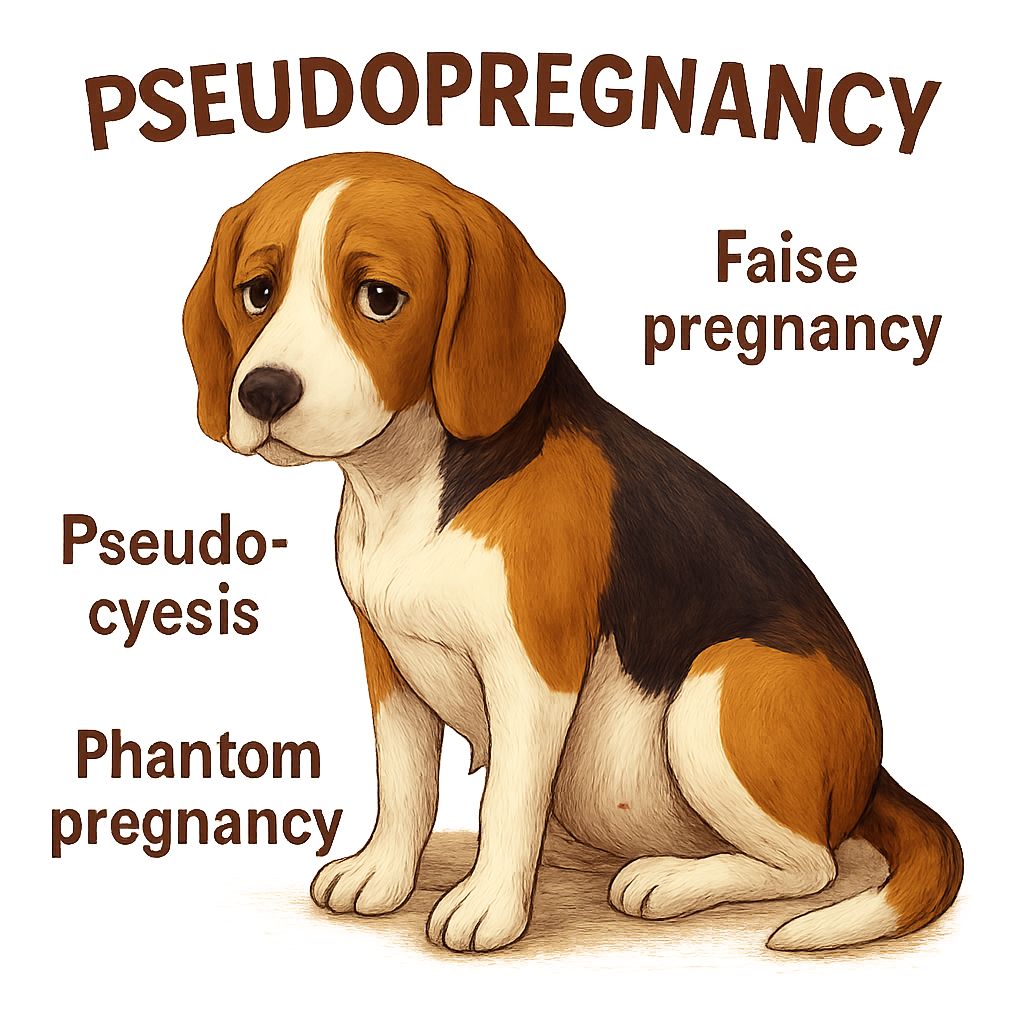
While pseudopregnancy in dogs isn’t usually dangerous, it can be confusing and even distressing for both dogs and their owners. “The good news is that pseudopregnancy is usually a harmless and self-limiting condition that resolves on its own without serious complications.” In this article, we’ll explain everything you need to know: what causes it, how to recognize the signs, when to worry, and what you can do to help your dog.
What Is Pseudopregnancy in Dogs?
Pseudopregnancy in dogs is a hormonal condition where a female dog shows signs of pregnancy—even though she isn’t pregnant. This happens due to natural hormonal fluctuations after her heat cycle. “Unfortunately, in some cases, pseudopregnancy can lead to distress, behavioral issues, or even medical problems if left unmanaged.”
Why Does It Happen?
In the wild, female dogs in a groups may experience pseudopregnancy to help nurture the offspring of the alpha female. Even in domestic dogs, this biological trait remains.
Here’s a simple breakdown of the process:
- After a heat cycle, progesterone (a pregnancy-supporting hormone) drops.
- Prolactin (a milk-producing hormone) rises, tricking the body into acting pregnant.
- The dog’s brain and body respond as if she’s expecting puppies.
How Progesterone Drop Triggers Pseudopregnancy in Dogs
After a female dog’s heat cycle (estrus), her ovaries produce progesterone—the hormone that prepares the body for pregnancy. If she doesn’t mate, progesterone levels drop sharply after ~2 months. This sudden decline signals the brain to release prolactin (a milk-stimulating hormone), tricking the body into acting pregnant—even when it’s not.
Process of Pseudopregnancy
[Heat Cycle Ends] │ ▼ [Progesterone Rises] │ (Prepares uterus for pregnancy) ▼ [No Pregnancy Occurs] │ ▼ [Progesterone Drops Gradually] │ (Over ~2 weeks) ▼ [Prolactin "Milk Hormone" Surges] ← Triggers: │ │ ▼ ▼ [Physical Changes] [Behavioral Changes] │ │ ▼ ▼ • Swollen Mammary Glands • Nesting (digging blankets) • Milk Production • "Adopting" Toys as Puppies • Weight Gain • Clinginess or Anxiety
| Stage | What Happens | Resulting Symptom |
|---|---|---|
| 1. Heat Cycle Ends | Progesterone rises to prepare uterus for pregnancy. | No visible signs yet. |
| 2. No Pregnancy | Progesterone drops after ~60 days (no fertilized embryos). | Hormonal confusion begins. |
| 3. Prolactin Surge | Brain misreads progesterone drop as “birth time” and releases prolactin. | Mammary glands swell; milk production. |
| 4. False Nesting | Body mimics labor instincts (nesting, mothering objects). | Dog carries toys, digs blankets. |
| 5. Behavioral Shifts | Hormones trigger maternal behaviors (clinginess, restlessness). | Acts protective or anxious. |
Simple Example Scenario For Psuedopregnancy In Dogs
Day 0-20 (Heat Cycle):
- Dog is in heat (attracts males but doesn’t mate).
Day 21-60 (High Progesterone):
- Uterus thickens as if expecting puppies.
Day 61+ (Progesterone Crash → Pseudopregnancy):
- Physical: Milk leaks, belly looks bloated.
- Behavioral: She “adopts” a stuffed toy and guards it fiercely.
Key Point
Pseudopregnancy is a hormonal domino effect—when progesterone falls, prolactin takes over, creating a phantom pregnancy. It’s natural but can be managed with vet guidance.
Case Study related to psuedopregnancy in dogs
Breed: Beagle (Max)
Day 0-9 (Estrus): Attracted male dogs but didn’t mate.
Day 45: Progesterone levels start falling.
Day 60: Prolactin rises → began collecting socks and whining.
Day 70: Produced milk; vet confirmed pseudopregnancy.
“Prolactin’s Trick: Why Your Dog Acts Pregnant (When She’s Not)
- The Hormone Mix-Up
- After a heat cycle, your dog’s body expects pregnancy.
- When no puppies arrive, prolactin (the “milk hormone”) still kicks in—like a false alarm.
- What Prolactin Does
- Tells the body: “Make milk!” → Swollen nipples, even leaking milk.
- Tells the brain: “Be a mom!” → Nesting, mothering toys (e.g., carrying socks like puppies).
- Why It Happens
- Wild dogs evolved this trick to help nurse other pups in their pack.
- Pet dogs keep this instinct, even without real babies.
Real-Life Example
Imagine your dog’s hormones like a mischievous puppeteer:
- Pulls the prolactin string → Her body obeys, acting pregnant.
- No puppies? She’ll “adopt” toys instead (and maybe glare at you for “stealing” them).
Key Note
Prolactin doesn’t know if your dog is pregnant—it just follows orders. That’s why false pregnancy looks so convincing!
Signs & Symptoms: How to Tell If Your Dog Has a False Pregnancy
Symptoms can range from mild (slight behavioral changes) to severe (full-blown nesting and milk production). Here’s what to watch for:
Physical Signs
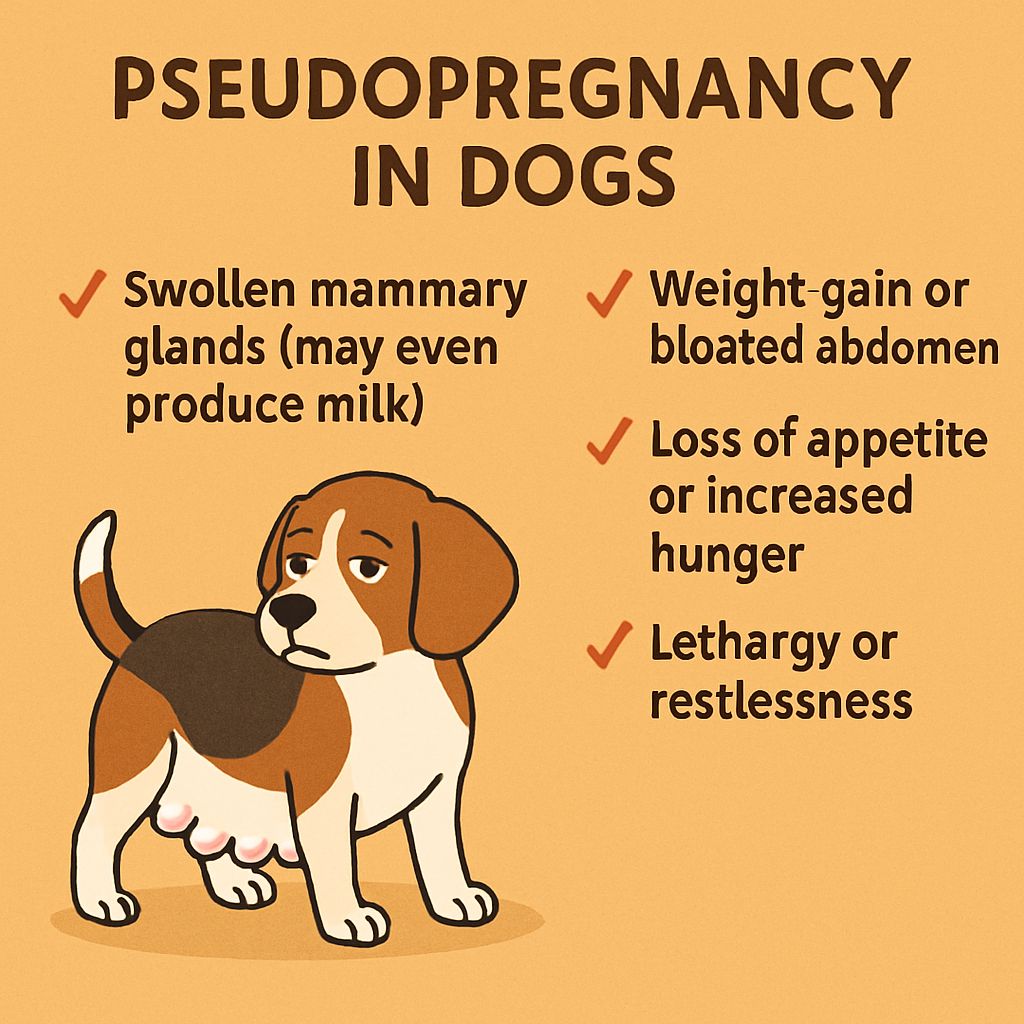
✔ Swollen mammary glands (may even produce milk)
✔ Weight gain or bloated abdomen
✔ Loss of appetite or increased hunger
✔ Lethargy or restlessness
Behavioral Signs
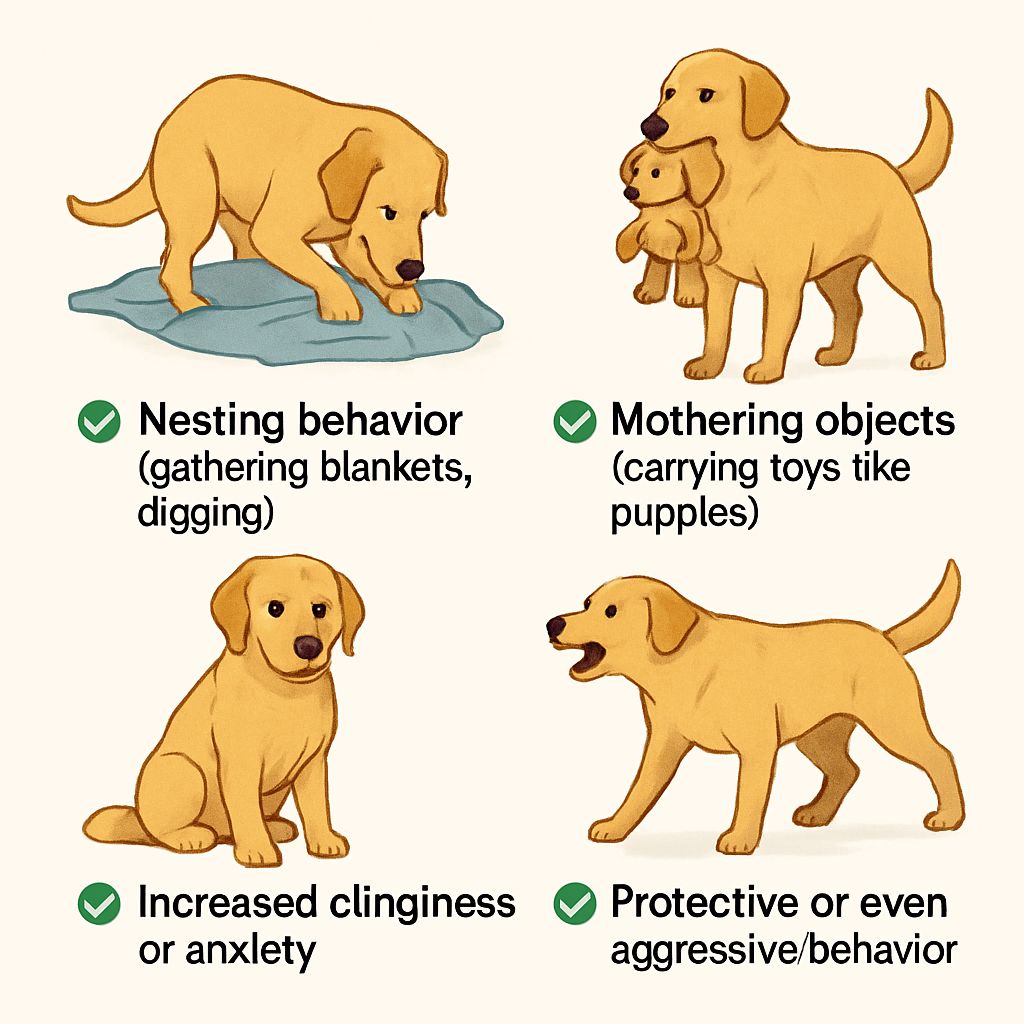
✔ Nesting behavior (gathering blankets, digging)
✔ Mothering objects (carrying toys like puppies)
✔ Increased clinginess or anxiety
✔ Protective or even aggressive behavior
Example Case: A 4-year-old unspayed Dachshund started hoarding socks in her bed and whining when separated from them. Her owner later noticed milk secretion—classic pseudopregnancy signs.
Methods to Diagnose Pseudopregnancy in Dogs
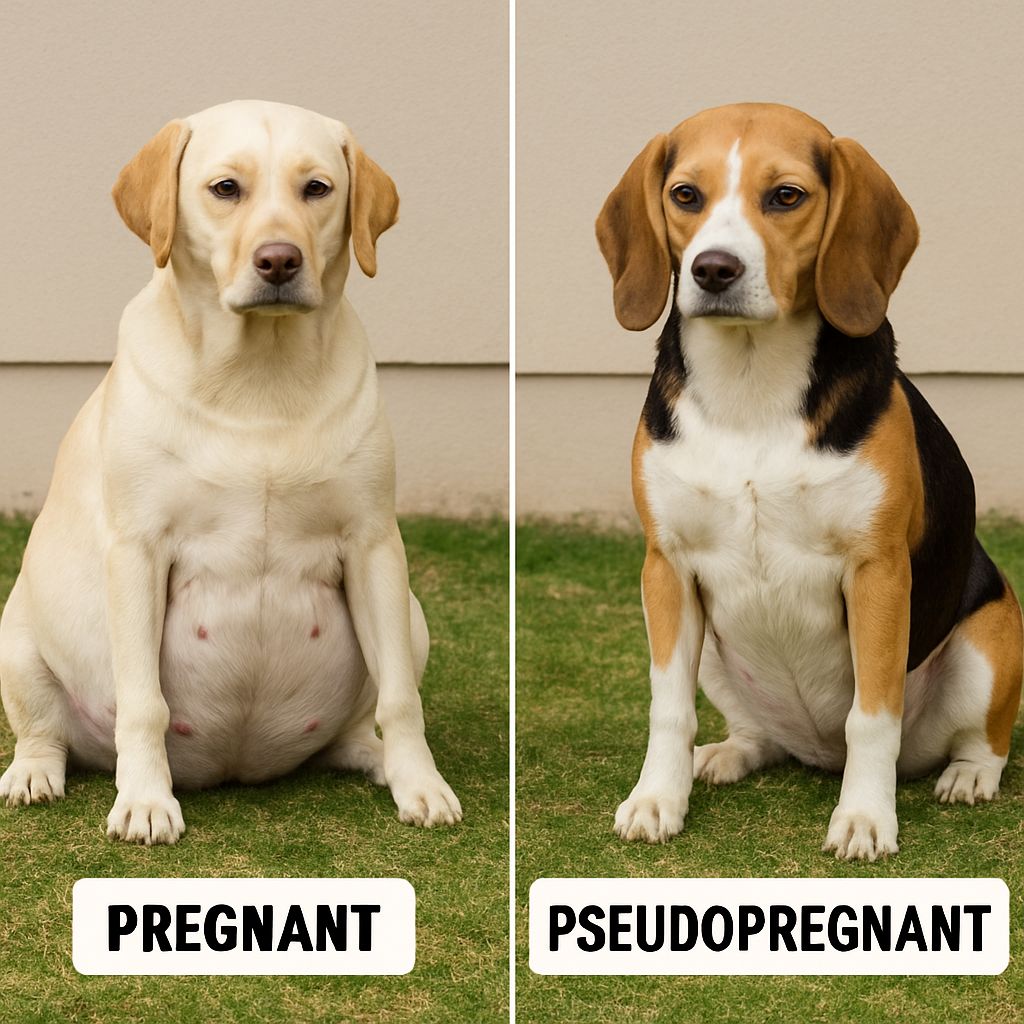
| Method | How It Works | What It Detects | When to Use |
|---|---|---|---|
| Physical Examination | Vet checks for: • Swollen mammary glands • Milk secretion • Abdominal palpation | Signs mimicking pregnancy (e.g., enlarged uterus) | First step if symptoms appear post-heat. |
| Behavioral Observation | Owner reports: • Nesting • Mothering objects • Restlessness/anxiety | Behavioral changes linked to hormonal shifts. | Mild cases (no medical intervention needed). |
| Hormone Tests | Blood tests measure: • Prolactin levels (elevated) • Progesterone (declining) | Confirms hormonal imbalance. | If symptoms are severe or prolonged. |
| Ultrasound/X-ray | Imaging rules out: • Actual pregnancy • Pyometra (uterine infection) | Absence of fetuses; uterine abnormalities. | If physical signs are ambiguous. |
| Response to Treatment | Trial with: • Hormone blockers prescribed by Vet | Symptoms improve → confirms pseudopregnancy. | For severe cases (e.g., mastitis). |
Is Pseudopregnancy In Dogs Dangerous? When to See a Vet
Most cases resolve on their own in 2-3 weeks, but complications can arise:
| Potential Risk | What to Do |
|---|---|
| Mastitis (infected mammary glands) | Warm compresses, vet-prescribed antibiotics |
| Severe anxiety or aggression | Behavioral training, vet may suggest mild sedatives |
| Prolonged symptoms (beyond 4 weeks) | Rule out real pregnancy or hormonal disorders |
When to Worry:
- If your dog seems in pain (whining, licking mammary glands excessively).
- If she stops eating or becomes unusually aggressive.
- If symptoms last longer than a month.
Treatment & Management Of Psuedopregnancy In Dogs: How to Help Your Dog
1. Do Nothing (Wait It Out)
Many mild cases resolve naturally. Avoid stimulating milk production by:
- Not touching her nipples (this can encourage lactation).
- Removing toys she’s “mothering” (to break the nesting habit).
2. Comfort Measures
- Increase exercise to reduce anxiety.
- Use a snug-fitting shirt to prevent excessive licking.
- Provide distractions (puzzle toys, extra playtime).
3. Medical Intervention (If Severe)
- Hormone therapy (only under vet supervision).
- Spaying (prevents future episodes).
Pro Tip: If you don’t plan to breed your dog, spaying is the best long-term solution to avoid recurring false pregnancies.
Best Supplements for Pseudopregnancy in Dogs

(Always consult your vet before use!)
| Supplement | How It Helps | Dosage & Notes |
|---|---|---|
| Chasteberry | Balances hormones (lowers prolactin). | As directed by Vet, Short-term use only. |
| Omega-3 Fish Oil | Reduces inflammation in swollen mammary glands. | Follow label weight guidelines – Supports skin/coat too. |
| Probiotics | Eases stress-related digestive upset. | Dog-specific strains – Mix with food. |
| L-Theanine | Calms anxiety (nesting/restlessness). | Chews or powder – Vet-approved brands only. |
| Milk Thistle | Supports liver (helps process excess hormones). | Small doses – Avoid if on other meds. |
What to Avoid In Psuedopregnancy In Dogs
✖ Dairy products (worsens milk production).
✖ Human herbal remedies (e.g., fenugreek – boosts lactation!).
Non-Supplement Tips
✔ Cold cabbage leaves (reduce mammary swelling).
✔ Snug-fitting shirt (prevents licking/irritation).
✔ Extra exercise (distracts from nesting).
Real-Life Example:
A Beagle’s false pregnancy improved within 10 days using:
- Chasteberry drops (AM/PM).
- Omega-3 in meals.
- 30-min extra walks daily.
When to See a Vet
- If symptoms last >4 weeks.
- If mammary glands are hot/painful (risk of infection).
Key Takeaway:
Supplements can help, but spaying is the best long-term solution for recurrent cases.
How To Prevent Pseudopregnancy in Dogs In the Future
The most effective prevention for psuedopregnancy in dogs is spaying. However, if you prefer keeping your dog intact:
- Monitor her closely after heat cycles.
- Avoid nipple stimulation (no milking or massaging).
- Keep her active to reduce hormonal stress.
Final Thoughts:
✔ Pseudopregnancy in dogs is normal but can be confusing—your dog isn’t sick, just hormonally tricked.
✔ Most cases resolve on their own within a few weeks.
✔ Watch for complications (mastitis, extreme anxiety).
✔ Spaying prevents future episodes if breeding isn’t planned.
If your dog is going through this, stay calm and supportive. With a little patience (and maybe a vet visit if needed), she’ll be back to her normal self soon!
Dog Breeds More Prone to Pseudopregnancy (False Pregnancy)
Pseudopregnancy can occur in any unspayed female dog, but some breeds are genetically predisposed due to hormonal sensitivity or breeding history. Below is a list of breeds with higher reported cases, along with possible reasons:
Breeds Most Affected by Pseudopregnancy
| Breed | Why More Prone? | Typical Symptoms Observed |
|---|---|---|
| Dachshund | Hormonal imbalances common; strong maternal instincts. | Nesting, milk production, guarding toys. |
| Beagle | High prolactin sensitivity; bred for pack behavior. | Restlessness, whining, swollen glands. |
| Poodle (Toy/Miniature) | Hormonal fluctuations due to small size. | Anxiety, mothering objects. |
| Shih Tzu | Prone to endocrine disorders; exaggerated false pregnancies. | Milk leakage, clinginess. |
| Boston Terrier | Strong hormonal responses post-heat. | Weight gain, nesting. |
| Chihuahua | Small breeds often have intense pseudopregnancies. | Aggression over “adopted” toys. |
| Cocker Spaniel | History of reproductive irregularities. | Mammary swelling, lethargy. |
| German Shepherd | High maternal drive (even in false pregnancies). | Digging, protective behavior. |
| Boxer | Hormonal sensitivity; frequent pseudopregnancy cases reported. | Milk production, abdominal bloating. |
| Basset Hound | Slow metabolism affects hormone regulation. | Persistent nesting, app |
Why Do Some Breeds Get It More?
- Genetic Hormonal Sensitivity
- Breeds like Dachshunds and Beagles often have stronger prolactin surges.
- High Maternal Instincts
- German Shepherds and Boxers may “act pregnant” due to pack-raising instincts.
- Small Breed Tendencies
- Chihuahuas and Toy Poodles have faster hormone cycles, increasing false pregnancy risks.
- Reproductive Traits
- Cocker Spaniels and Shih Tzus are prone to endocrine imbalances.
What Owners of These Breeds Should Do
✔ Monitor post-heat behavior (weeks 6–12).
✔ Distract with play/exercise to reduce nesting.
✔ Avoid nipple stimulation (worsens milk production).
✔ Consider spaying if recurrent (prevents future episodes).
Real-Life Example
A Miniature Schnauzer had 3 false pregnancies in 2 years—each time, she:
- Produced milk.
- Hid under beds with stolen socks.
- Solution: Spaying resolved it completely.
Key Takeaway
While any unspayed dog can experience pseudopregnancy, these breeds need extra vigilance. If symptoms are severe (e.g., infection, aggression), consult a vet.
Have You Experienced This With Your Dog?
Share your story in the comments below so that we can add your experiences in our article—many pet owners don’t realize how common pseudopregnancy is until it happens to their pup!
At Last But Not Least
“While pseudopregnancy in dogs is always a problematic condition for pet parents. It may confuse your dog—and worry you—remember: it’s her loving heart, not logic, at work. Those motherly instincts, though misplaced, show just how deeply she’s wired to care. With patience and vet guidance, this false alarm will pass… until then, cherish the extra cuddles (and maybe rescue those ‘adopted’ socks!). After all, even imaginary puppies deserve her best—because to her, love is always real.”
People Also Asks
1. What causes ectopic pregnancy in dogs?
Ectopic pregnancy in dogs occurs when embryos implant outside the uterus (e.g., abdomen, oviducts), usually due to scarring, hormonal issues, or birth defects. It’s life-threatening—causing internal bleeding or infection—and requires emergency vet care.
2. How long does pseudopregnancy last in dogs?
Typical Duration:
- Mild cases: 2–3 weeks (resolves on its own).
- Severe cases: Up to 4–6 weeks (may need vet help).
3. Should I milk my dog during a false pregnancy?
No,it can stimulate more milk and chances of infection also increases.
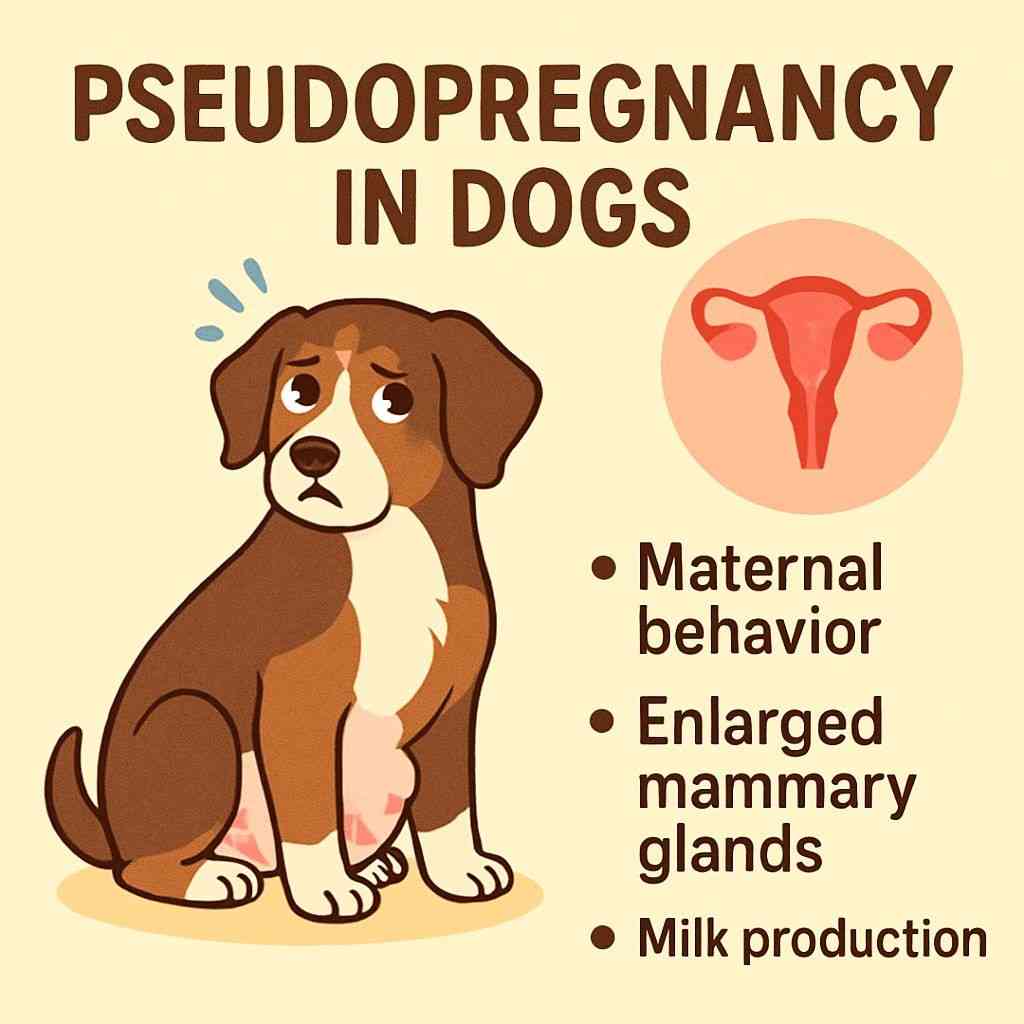
2 thoughts on “Pseudopregnancy in Dogs: A Comprehensive Guide for Pet Owners”